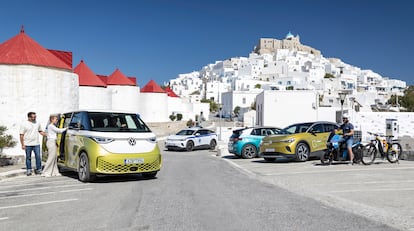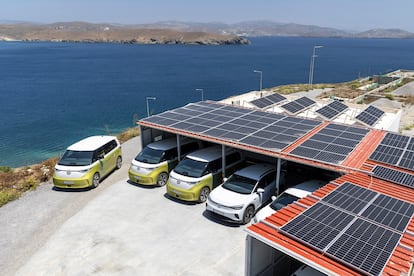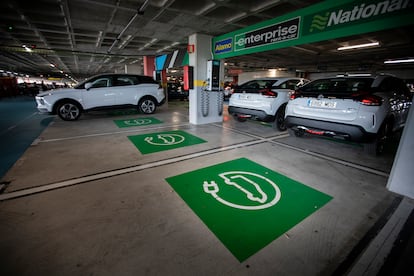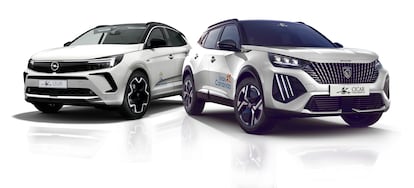Shared vans, electric cars for tourists and the end of diesel by 2025: islands anticipate the mobility of the future
A small Greek island is testing full electrification, while Spain’s Balearic and Canary Islands take advantage of their size to take national transport regulations further

An electric van meanders along a winding road as softly as the sun-drenched waves lap upon the shore. The driver stops and greets a young man, who climbs in and sits in the rear seats. Four minutes later, a young woman gets in. The route, which takes just 15 minutes, has been adapted at the request of the three passengers, who have previously booked their route using a mobile application. This innovative on-demand electric public transport is not operating in a large city or in a modern industrial centre, but in Astypalea, a secluded Greek island of just 1,400 inhabitants and shaped like a butterfly. The island territories — the Balearic and Canary Islands in Spain — which are more vulnerable to climate change, are taking advantage of their smaller landmass to promote more rapid changes that anticipate what future mobility will look like.
“Islands have a limited surface area, and that allows them to make the transition to more sustainable mobility sooner,” notes May Lopez, spokeswoman for Businesses for Sustainable Mobility. “On the one hand, there are a lot of rental car fleets that are frequently renewed, and rental companies can be set more ambitious targets than private individuals; on the other hand, they are also undertaking projects to push LNG gas and hydrogen in shipping,” she continues.

Astypalea, which is becoming known as “electric island,” is the testing ground for a powerful electrification project — driven by the Greek government and Volkswagen Group — to replace all its combustion vehicles with zero-emission vehicles. On the one hand, they have launched Astybus, an on-demand service provided by five electric vans that pick up passengers and take them to locations they have previously chosen using a mobile app. “A cab would have cost me €10 ($11), this one costs me five, the problem is that the service stops at 8pm,” explains one of the users. In addition, the ambulance that covers the island’s three villages is also electrified, as are the police cars and the Spanish-made motorcycle ridden by its mayor, Nikolaos Komineas.
At the moment, there are 84 electric vehicles on the island (almost all Volkswagen), which are still in the minority compared to the total number of vehicles on the island. The Greek state is offering potential buyers the largest public subsidy in the whole country for the purchase of a zero-emission car, up to €12,000 ($13,120), to carry forward an ambitious project which, in addition to replacing old cars, will be accompanied in the summer by Greece’s first car-sharing scheme: cars, motorcycles and bicycles (all electric) can be booked through an app designed by Code, a subsidiary of Seat.

Astypalea has become a laboratory to find out to what extent carbon neutral mobility is possible. Just an hour’s flight from Athens, this island of classic white buildings with its indigo-crowned churches seems to be the perfect size for testing: 97 square kilometers (37.45 square miles), 1,330 inhabitants (although it receives 36,000 tourists in the summer months) and 1,500 vehicles. Maik Stephan, head of Business Development at Volkswagen Group, avoids setting dates for achieving the goal of full electric mobility, but believes that, under his plans, the total fleet of vehicles that the island will eventually have will be reduced by a third thanks to shared mobility. “It is a transition that is taking time, but it is already producing results. It’s not just theory,” the island’s Mayor Komineas adds.
Balearic and Canary Islands
Spain’s island territories are also implementing interesting mobility measures. For example, the Balearic Islands passed its Climate Change Law in 2019 — two years ahead of national regulations — and includes ambitious targets, the most notable of which is a ban on new diesel vehicles entering the region from 2025 (bringing the European Union’s veto on combustion engines forward by a decade). The regulation includes an obligation to install recharging points in parking lots and cover them with solar panels, as well as the creation of sustainable mobility plans in large workplaces. This last measure is not yet in force in the rest of Spain, as the state’s Sustainable Mobility Law has not yet been approved.

More interesting is the electrification of fleets of vacation rental cars. Nationally it remains tiny: in the first four months of the year, rental companies registered 60,000 new cars, of which only 1,200 were electric (0.18% of the total of around 650,000 vehicles for rent). The Balearic Islands already requires 2% of them to be zero emissions (5% by 2025, and 15% by 2030). The sector believes that it is too early: “The customer hardly ever asks for electric vehicles, as there is a clear problem in Spain because of a lack of charging infrastructure. Imposing this type of fee means that many electric vehicles will be left on the lot, even during the peak-demand season,” explains a spokeswoman for Feneval, which brings together most of the car rental companies operating in Spain.
Arturo Pérez de Lucia, director of the Business Association for Electric Mobility (Aedive), responds: “More and more tourists are looking for sustainable solutions for their vacations. The electric vehicle is still a challenge for two reasons. One is economic, since rental prices are more expensive than combustion engines, and another is the a fear of the recharging experience. But it should be remembered that there are already 100% electric models whose battery range is more than enough to travel around each of the islands from end to end for several days without needing to recharge.” May López adds, “Tourists stay in hotels that must have charging points, use parking lots where recharging must also be possible, and they usually travel less distance; it is an ideal sector to advance electrification.”
Meanwhile, the Canary Islands passed its counterpart law in 2022, which requires companies to draw up sustainable mobility plans, and provide free on-street parking for electric cars. Administrations are required to promote cycling and build protected bike lanes, and the public sector is to replace all its combustion vehicles with zero-emission ones by 2032; for car rental companies this deadline has been extended to 2037 — for now their purchase is exempt from IGIC, the Canary Islands’ sales tax. However, there are already car rental brands that are moving ahead, such as Cicar, which has around 15,000 vehicles throughout the islands, 15% of which are already electric, hybrid and LNG. According to Javier Martín, spokesman for the company, “the recharging points are still not enough to cover all the vehicles. However, the customer who travels to the island on business for a day does usually request this type of car, since the battery range is sufficient for a day.”

According to Aedive data from the end of 2022, there are about 10,000 electric cars registered in the Canary Islands (both pure and plug-in hybrids), twice as many as in the Balearic Islands (about 5,000). According to data from the dealer association Ganvam, the Canary Islands has been the third largest pure electric car dealer in Spain since 2020, while the Balearic Islands was the eighth in 2020 and is now the sixth. In terms of infrastructure, Aedive has counted 625 public charging points in the Canary Islands and 888 in the Balearic Islands (the latter with one of the best averages in Spain); the Balearic Government has increased this figure to 1,000 points, while the Canary Islands has 1,260 (some have been installed this year and others are not yet active).
“The archipelagos are one of the territories that are most vulnerable to the effects of climate change if we do not take brave steps against this phenomenon,” says José Antonio Valbuena, acting Canary Islands Minister of Ecological Transition. “That’s why we set full decarbonization for 2040, 10 years ahead of Spain and the rest of Europe,” he continues.
Low emission zones
Juan Pedro Yllanes, his appointed Balearic counterpart, is of a similar opinion: “The extent of the islands makes expanding electric mobility possible due to the size of the territory. In fact, entire islands can be declared Low Emission Zones thanks to the state’s climate change law. They are part of the Clean Energy for EU Islands program to advance decarbonization targets relative to the mainland, and are considering advancing the timetable for decarbonization by setting 2040 as a possible deadline.”
López expresses a reservation: “The islands are advancing in decarbonizing fleet vehicles more than the rest of Spain, but they are still lagging behind in terms of electrification of public transport and should spend more on that.” According to a recent survey by EL PAÍS, Palma de Mallorca has only 11 electric buses out of 178, and Las Palmas de Gran Canaria, has only one out of 250. In any case, both cities have ordered more vehicles of this type for the coming months.
Another issue that concerns the islands is their ability to provide themselves with clean energy: even if a vehicle is electric, the key is how that electricity is generated, either from renewable sources or from fossil fuels. Astypalea is an example: its electricity generation depends on a plant that burns 1.8 billion liters (395.9 million gallons) of diesel per year. The ambitious program includes the construction of a plant powered by solar panels and an energy accumulator during the hours when the sun is not shining, which will start operating next year. Meanwhile, the Balearic Islands already meets 25% of its electricity demand with renewables, and in the Canary Islands the figure is around 20%. According to the Ministry for Ecological Transition, the islands have isolated power grids, which is why they need to incorporate storage to fully integrate renewable energies. That is the real future of zero emissions in transportation.
The challenges of on-demand transportation
“It is an experiment, but on-demand transportation in metropolitan and very densely populated areas is very difficult to carry out and in the Balearic Islands it would not be possible either,” says Lidia Montero, professor at the Polytechnic University of Catalonia and specialist in the application of statistics to transport planning. In 2006, she participated in a study on the possibility of implementing a service like Astypalea’s in Barcelona, with 1,500 eight-seater vans. The results of the microsimulation made the viability of this public transport project impossible. Assuming that they covered 10% of the demand, they concluded that during the entire service each of these vans would have transported an average of 1.5 people. The additional route, required to serve all passengers, reduced the chances of success, although Montero asserts that that a system of stops like the one used on the Greek island would improve the results.
Sign up for our weekly newsletter to get more English-language news coverage from EL PAÍS USA Edition
Tu suscripción se está usando en otro dispositivo
¿Quieres añadir otro usuario a tu suscripción?
Si continúas leyendo en este dispositivo, no se podrá leer en el otro.
FlechaTu suscripción se está usando en otro dispositivo y solo puedes acceder a EL PAÍS desde un dispositivo a la vez.
Si quieres compartir tu cuenta, cambia tu suscripción a la modalidad Premium, así podrás añadir otro usuario. Cada uno accederá con su propia cuenta de email, lo que os permitirá personalizar vuestra experiencia en EL PAÍS.
¿Tienes una suscripción de empresa? Accede aquí para contratar más cuentas.
En el caso de no saber quién está usando tu cuenta, te recomendamos cambiar tu contraseña aquí.
Si decides continuar compartiendo tu cuenta, este mensaje se mostrará en tu dispositivo y en el de la otra persona que está usando tu cuenta de forma indefinida, afectando a tu experiencia de lectura. Puedes consultar aquí los términos y condiciones de la suscripción digital.
More information

Latin American and Caribbean cities: Championing local solutions for global challenges
Archived In
Últimas noticias
Welcome to the post-religion era: The idea of Christianity as the absolute truth has become obsolete
‘I thought you would like it’: The risky sexual practice popularized by TV shows and TikTok
The digitalization of tourism: ‘They promise experiences and gave us the worst possible one’
Mexican peso defies uncertainty with forecasts of a new period of stability in 2026
Most viewed
- Sinaloa Cartel war is taking its toll on Los Chapitos
- Reinhard Genzel, Nobel laureate in physics: ‘One-minute videos will never give you the truth’
- Oona Chaplin: ‘I told James Cameron that I was living in a treehouse and starting a permaculture project with a friend’
- Why the price of coffee has skyrocketed: from Brazilian plantations to specialty coffee houses
- Silver prices are going crazy: This is what’s fueling the rally









































